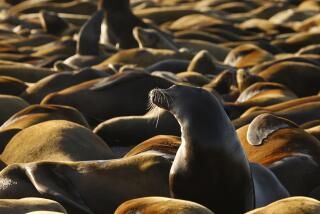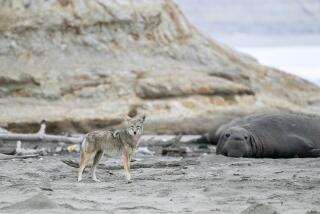Baby Seals’ Plight Only a Siren Song
- Share via
MOSCOW — Forty-three softhearted Russian sailors who offered to risk their lives to save thousands of baby harp seals were ordered Saturday to drop the controversial rescue mission after reports of 200,000 to 350,000 starving animals turned out to be grossly exaggerated.
In fact, there were about 5,000 seals in trouble--a fraction of the number clubbed to death for their pelts every year in northern Russia.
Yet even had there been hundreds of thousands of desperate, starving seals trapped on the ice in the White Sea, Russian scientists said, the planned rescue effort was “sheer idiocy” and misconceived from the start.
“The very idea of sending a rescue party sounds phony,” said Yuri Timoshenko, senior researcher on harp seals at the Arkhangelsk Polar Ocean and Fish Research Institute, who has been studying the animals for more than 40 years.
“We kill tens of thousands of seals a year, and all of a sudden someone comes up with this ridiculous idea. The need to save the seals in the White Sea has been exaggerated since the very beginning,” he complained in a phone interview Friday, calling for the rescue effort to be abandoned.
Vladimir Potelov, another top seal expert at the institute, set off the initial alarm after an aerial survey April 27, announcing that the mass death of 200,000 to 350,000 baby seals was inevitable.
The seals, he reported, were trapped on ice floes in the White Sea where there was inadequate food available. The ice floes normally drift into the Barents Sea, where food is plentiful, but they were slower in breaking away from the shore this year.
The scientist was astounded by the response. Foreign journalists flew to the area. Sailors from the Murmansk Shipping Co., touched by the plight of the animals, volunteered to mount a rescue mission. A meeting of 13 top experts was convened at the Kremlin’s Ministry of Emergency Situations.
“Somebody has to help them. We can’t stay aloof from this tragedy. We firmly believe that it is not a regional matter but a global problem,” Vladimir Blinov of Murmansk Shipping said by phone Thursday, explaining the company’s decision to send an icebreaker and a crew of 43.
He also admitted quite frankly that the men didn’t have a clue as to how to go about the job.
“We don’t know much about saving seals, but all the sailors here understand that somebody should go out there and do this job,” he said gamely.
But even Potelov was scathing about the well-meaning sailors, describing their mission as “sheer idiocy.”
For a start, he pointed out in an interview Thursday, it would not be easy to rescue the seals, who are not helpless babies but 2 months old and agile.
“It is a nice but extremely stupid and primitive idea,” he declared. “You can chase them as much as you like, jumping between ice floes and drowning or breaking your skull, but you will never catch a single one of them.
“They won’t heed your wonderful, nature-loving ideas. They’ll run like hell.
“It’s a crazy idea, and neither I nor any of my men will join such a loony venture,” he added.
Other experts, meanwhile, warned that the ice in the area was treacherously mushy.
“Ordering people to land on the ice could well mean that there were more dead people than rescued seals,” Timoshenko said after a second air survey Friday established that there were only a few thousand seals in the area, not 200,000.
By then, even seal-loving groups were recommending against the rescue.
“There is no sign of a catastrophe that would require human interference,” said Maria Vorontsova, director of the Russia office of the International Fund for Animal Welfare, who was present during Friday’s air survey.
She viewed a tape of the April 27 aerial survey and believed that the subsequent count of starving seals was wrong.
Timoshenko agreed that the initial estimate was wrong and attributed the figure to Vladimir Stasenko, the director of the Polar Ocean and Fish Research Institute.
On Saturday morning, the shipping company pulled out of the rescue, but company spokeswoman Larisa Medvedeva could not keep the disappointment out of her voice.
“Unfortunately, we have been told by scientists that there is no need to save the seals. But honest to God, we sincerely wanted to help these poor animals. They’re not to blame that nature has turned against them this year,” she said.
Timoshenko said a couple of thousand seal deaths would have no long-term effect on the seal population.
The Sea Mammal Research Unit at St. Andrews University in Britain estimates the global population of harp seals at between 7 million and 8 million.
Vorontsova, of the International Fund for Animal Welfare, said of much greater concern is the annual mass slaughter of seal cubs, which she described as barbaric and cruel.
Russia’s quota for commercial slaughter of harp seal cubs in 2001 was 113,250--equivalent to a third of those born in the White Sea annually--but 39,111 were actually killed in March.
Timoshenko said the shortfall occurred because of a decline in the seal-pelt industry in Russia.
*
Alexei Kuznetsov and Sergei Loiko of The Times’ Moscow Bureau contributed to this report.
More to Read
Sign up for Essential California
The most important California stories and recommendations in your inbox every morning.
You may occasionally receive promotional content from the Los Angeles Times.













